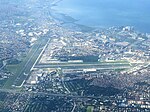FTI station

FTI station (also called Food Terminal Junction station) is a railway station located on the South Main Line in Taguig, Metro Manila, Philippines. It is named after its major landmark, the grounds of the formerly state-owned Food Terminal, Inc. which is now renamed as Arca South. The station is the thirteenth station from Tutuban and is one of two stations serving Taguig, the other station being Nichols. The station was opened on January 19, 1977 as Food Terminal Junction station, replacing the now-defunct Balagbag station that was located few meters northwest. In 2018, PNR extended the North Shuttle Line southwards from Dela Rosa to FTI as its new terminus, effectively starting on September 10, while northwards from Caloocan to Governor Pascual started on December 3.
Excerpt from the Wikipedia article FTI station (License: CC BY-SA 3.0, Authors, Images).FTI station
Skyway, Parañaque
Geographical coordinates (GPS) Address Nearby Places Show on map
Geographical coordinates (GPS)
| Latitude | Longitude |
|---|---|
| N 14.5068 ° | E 121.03536388889 ° |
Address
Skyway
Skyway
1700 Parañaque
Philippines
Open on Google Maps








